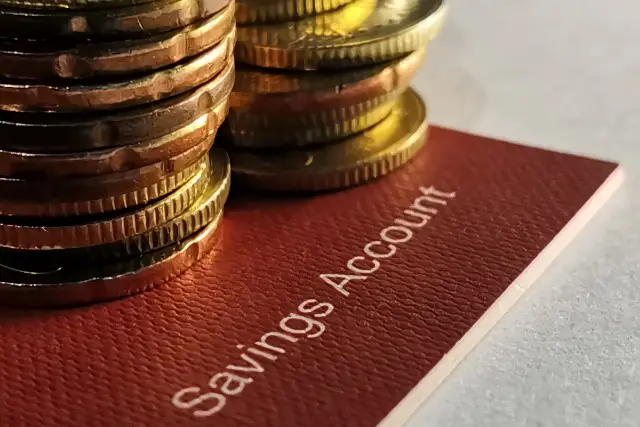A high-yield savings account can be a great way to save money and/or build an emergency fund.
These accounts offer unique benefits to traditional savings accounts, making it easier to grow your savings.
In this article, we will discuss what a high-yield savings account is and how it works.
We will also explore the benefits of using one of these accounts and whether or not it is right for you.
This post may contain affiliate links; please see our disclaimer for details.

Table of Contents
What Is a High-Yield Savings Account?
A high-yield savings account is a type of savings account that offers a higher interest rate than a traditional savings account.
A higher interest rate means you will earn more money on your deposits over time.
Many types of high-yield savings accounts are available, each with its own set of benefits and drawbacks.
When choosing a high-yield savings account, it is important to compare the features and fees of each option to find the best fit for your needs.
You can find high-yield savings accounts at both online and brick-and-mortar banks.
Many online banks offer higher interest rates than traditional banks, so it is worth considering an online option if you are looking for the best return on your investment.
A great place to get started with your savings account is CIT Bank. They offer very competitive saving rates with no monthly maintenance fees.
With their Saving Connect Account, you can earn 12x the national average! There are no ATM fees, and you have the convenience of online banking.
Rest assured, CIT Bank is also FDIC insured!

How does a High-Yield Savings Account work?
A high-yield savings account works just like a regular savings account, with a few key differences.
First, as we mentioned earlier, these accounts offer a higher interest rate. This means that your money will grow faster over time.
You earn interest from a high-yield savings account because the bank uses your money to make investments.
In return for letting the bank use your money, they agree to pay you a certain amount of interest.
This process is known as fractional-reserve banking, which is how all banks operate.
When you deposit $1 into your high-yield savings account, the banks can lend out $0.90.
They keep the other $0.10 in their reserves. So while your currency can be protected by insurance, technically, it is not 100% backed by physical currency.
If everyone demanded their money back simultaneously, the banks would not be able to immediately give everyone their money back.
This is why it is important to only keep as much money in your savings account as you need.
The FDIC (Federal Deposit Insurance Corporation) protects deposits of up to $250,000 per account holder per bank.
So if your bank happens to fail, the FDIC will reimburse you for any losses up to $250,000.
This insurance can be a reason to keep your money in a savings account because keeping your wealth in other assets, such as stocks or real estate, exposes you to more risk.
With these assets, there is no insurance unless you purchase them yourself.
Without insurance, you are unprotected when the stock market crashes or your house burns down.
While the interest rate is higher with a high-yield savings account, a higher minimum balance is also required.
The minimum balance is usually $500, but it can vary from bank to bank.
There may also be fees associated with high-yield savings accounts. These fees can include monthly maintenance fees, account opening fees, and balance transfer fees.
The purpose of the fees is to make the high-yield savings account work because the banks are using your money to make investments.
These investments come with some costs as well. The fees also help to offset the risk that the bank is taking by lending out your money.
The interest rate on a high-yield savings account is typically lower than what you would earn from investing in stocks or bonds.
However, these accounts are much less risky and offer guaranteed returns.
What Are the Benefits of a High-Yield Savings Account?
There are a few benefits that come with using a high-yield savings account.
Your money will grow faster over time. Most high-yield savings accounts offer a return of around 0.50%.
While this may not seem like much, it is important to remember that the interest is compounded.
This means that the interest you earn is added to your account balance, and then interest is earned on that amount.
Let’s say you have $1000 in your high-yield savings account, and it has an annual interest rate of 0.50%.
After one year, you will have $1005 in your account. The next year you will earn interest on the $1005, not just the $1000.
Doing this can lead to your money growing much faster than it would in a regular savings account.
Another benefit is that high-yield savings accounts can help you reach your financial goals sooner.
If you are saving for a specific goal, such as a down payment on a house or retirement, a high-yield account can help you get there faster.
Finally, high-yield savings accounts can offer peace of mind.
Knowing that your money is growing and working for you can be a great comfort, especially in uncertain times.
These benefits make the high-yield savings account a great option for those looking to save money. However, they may not be right for everyone.
Is a High-Yield Savings Account Right for You?
Now that we’ve answered the question, “what is a high-yield savings account?” it’s time to ask ourselves whether or not we need one.
The answer to this question is going to be different for everyone.
You might want to consider using high-yield savings account for many reasons.
If you are looking to save money for a specific goal, such as a down payment on a house or retirement, these accounts can help you get there faster.
The higher interest rate will allow your money to grow faster.
You may not want to store your currency in other investments while saving for these specific goals.
This is because other investments, such as stocks or cryptocurrency, can be volatile. So the value of your investment can go up or down, and you could lose money.
Another reason to consider using a high-yield savings account is if you are building an emergency fund.
These accounts can offer peace of mind, knowing that your money is working for you and growing even when the stock market is down.
Your emergency fund will be there for you when you need it, and you won’t have to worry about losing any of your hard-earned money.
Related Content: Emergency Fund – What is It and Why You Need One?
A high-yield savings account may be a good option if you are looking for a safe and guaranteed way to grow your money.
If you don’t have much money saved up, a high-yield savings account can help you reach your financial goals faster.
However, you should be aware of the inflation rate when evaluating the rate of return from high-yield savings accounts.
If the interest rate on your account is lower than the inflation rate, you are losing money in real terms.
You should also be aware of the fees associated with high-yield savings accounts. Some accounts have minimum balance requirements or monthly fees.
Be sure to check the terms and conditions of each account before opening one to avoid any unwanted surprises down the road.
The bottom line is that there is no right or wrong answer when choosing a savings account. It all depends on your unique financial situation and what your goals are.
If you’re still unsure whether a high-yield savings account is right for you, we recommend talking to a financial advisor.
They can help you assess your needs and make the best decision.
No matter what type of savings account you choose, the important thing is that you are saving money.
Just thinking with this money sets you apart from the desire to buy items you may not need consistently.
Savings is key to a prosperous future. So if a high-yield savings account sounds right for you, open one up. You’ll be glad you did!
In Conclusion
A high-yield savings account may be a good option if you’re looking for a safe place to park your money and earn a little interest.
Just shop around for the best rates and terms before opening an account.
Understanding how they work and when they can be beneficial is also important.
According to DepositAccounts, the top three 2022 high-Interest Savings Accounts can be found at Captial One, American Express National Bank, and CIT Bank. You can learn more by visiting each site.
Evaluate your financial needs and goals to see if a high-yield savings account is right. If you found this article helpful, share it with your friends!
Disclaimer:
We hope the information in this article provides valuable insights to every reader but we, the Biesingers, are not financial advisors. When making your personal finance decisions, research multiple sources and/or receive advice from a licensed professional. As always, we wish you the best in your pursuit of financial independence!

